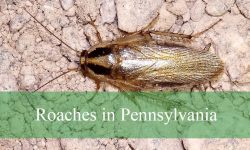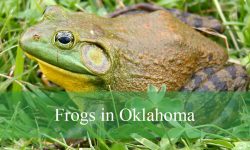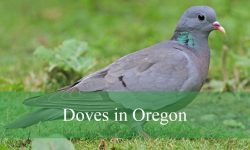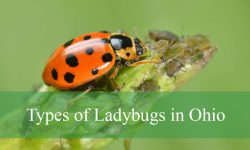Idaho’s vast wilderness, stretching from desert valleys to alpine forests, provides sanctuary for a remarkable diversity of owls. These secretive night hunters thrive in every corner of the state, each species uniquely adapted to its habitat. Their haunting calls and silent flights add mystery to Idaho’s evenings and early mornings.
Throughout the year, the skies and treetops come alive with owls ranging from the majestic Great Horned Owl to the tiny Northern Pygmy-Owl. Each bird has distinct markings, voices, and behaviors that reveal the complexity of Idaho’s ecosystems. Observing them offers a glimpse into the delicate balance of nature that sustains wildlife here.
This guide explores fourteen owl species found across Idaho, highlighting their appearance, habits, and preferred habitats. Understanding their traits helps birdwatchers and nature lovers recognize these nocturnal wonders and appreciate their role in maintaining healthy environments across the Gem State.
Common Types of Owls Found in Idaho
Great Horned Owl (Bubo virginianus)
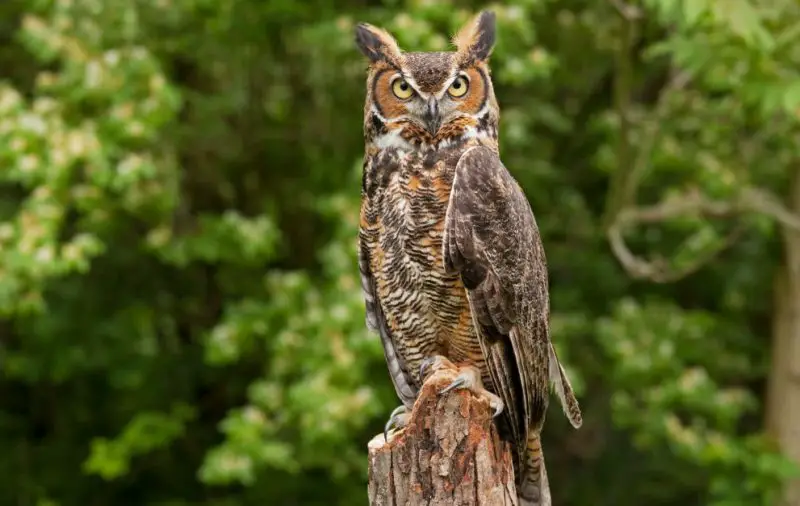
The Great Horned Owl is the most widespread owl species across Idaho, recognized for its large size, powerful build, and prominent feathered tufts that resemble horns. Adults typically measure between 18 to 25 inches in length with wingspans reaching up to 5 feet. Their plumage varies from gray-brown to tawny with dense barring, helping them blend seamlessly into tree bark and rocky terrain.
Identification of this owl is often aided by its deep, resonant “hoo-hoo-hoo” call, which echoes through Idaho’s forests and open plains at dusk. The facial disk is pale with striking yellow eyes and a dark outline that gives it an intense, commanding expression. Its legs and feet are covered in thick feathers, offering protection against cold northern nights.
Behaviorally, the Great Horned Owl is a powerful nocturnal hunter known for its stealth and diverse diet. It preys on rabbits, rodents, snakes, and even other birds, making it a top avian predator in Idaho’s ecosystems. Unlike many other owls, it does not build its own nest but instead takes over abandoned nests built by hawks or crows.
In Idaho, this adaptable species can be found in nearly every region—from the forests of the Panhandle to the high desert valleys of the south. It thrives in both wilderness areas and rural farmlands, often perching on fence posts or tall trees at dusk. The Great Horned Owl’s adaptability and fierce hunting skills make it a dominant presence throughout the state’s varied landscapes.
Barn Owl (Tyto alba)
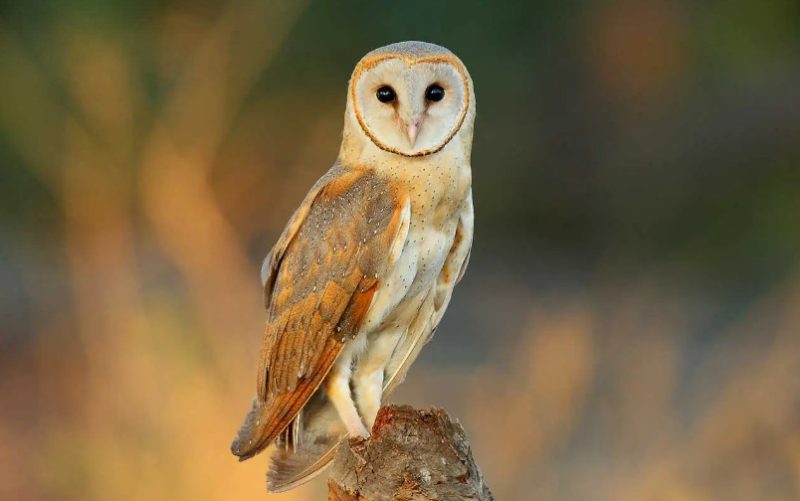
The Barn Owl is a hauntingly beautiful bird with a heart-shaped white face, dark eyes, and long, rounded wings. Measuring 12 to 15 inches in length and boasting a wingspan of about 3.5 feet, it glides silently through Idaho’s farmlands and grasslands in search of prey. Its golden-buff back and pure white underparts make it easily recognizable in the moonlight.
Unlike many other owls, the Barn Owl lacks ear tufts and has an elegant, slender body built for low, silent flight. Its call is not a hoot but an unearthly screech that can send shivers through the night air. This sound, coupled with its pale appearance, has earned it the nickname “ghost owl” among rural communities in Idaho.
Barn Owls are expert rodent hunters, relying primarily on their exceptional hearing to detect the faint rustle of mice or voles under thick grass. They are capable of pinpointing prey in complete darkness, thanks to their asymmetrical ear placement and acute auditory sense. Their diet plays a vital role in controlling pest populations around agricultural lands.
In Idaho, these owls favor open country, agricultural fields, and rural barns—often nesting in hollow trees, haylofts, or man-made nest boxes. They are most frequently seen in southern and southwestern Idaho, particularly near Boise and the Snake River Plain. Mild winters and abundant farmland make these regions ideal for sustaining healthy Barn Owl populations.
Western Screech-Owl (Megascops kennicottii)
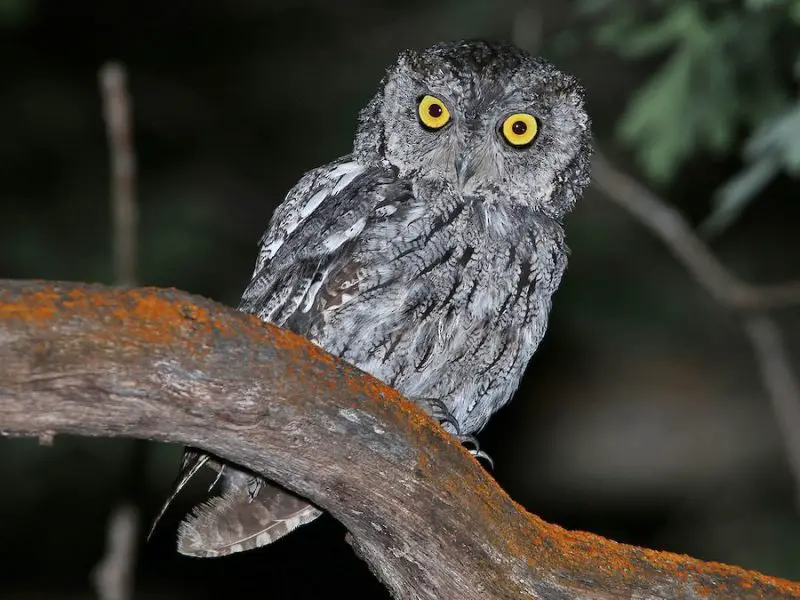
The Western Screech-Owl is a small but tough predator, only about 8 to 10 inches in length, with mottled gray or brown plumage that camouflages perfectly against tree bark. Its compact body, rounded head, and yellow eyes give it a distinctive, alert appearance. Despite its name, this owl doesn’t “screech” but emits a series of soft trills and short whistles that echo gently through Idaho’s riparian woodlands.
This owl can often be identified by its ear tufts and its habit of remaining motionless during the day, blending into the bark of cottonwoods or junipers. At night, it becomes an active hunter, swooping down to capture insects, small rodents, and even tiny birds. Its flight is silent and precise, a result of its specialized wing structure that reduces air turbulence.
The Western Screech-Owl is known for its adaptability to various habitats. It often takes up residence near rivers, canyons, and suburban parks, where old trees provide perfect nesting cavities. Unlike larger owls, it does not build nests but uses natural holes or old woodpecker excavations. Mated pairs often return to the same nesting sites year after year.
In Idaho, this species is widespread in the southwestern regions, including along the Boise River and Snake River corridors. They are especially active in warmer months and can sometimes be attracted to backyards with mature trees. Their quiet, elusive nature makes them more often heard than seen, yet their presence is vital to maintaining balanced ecosystems in Idaho’s semi-arid and riparian zones.
Northern Saw-whet Owl (Aegolius acadicus)
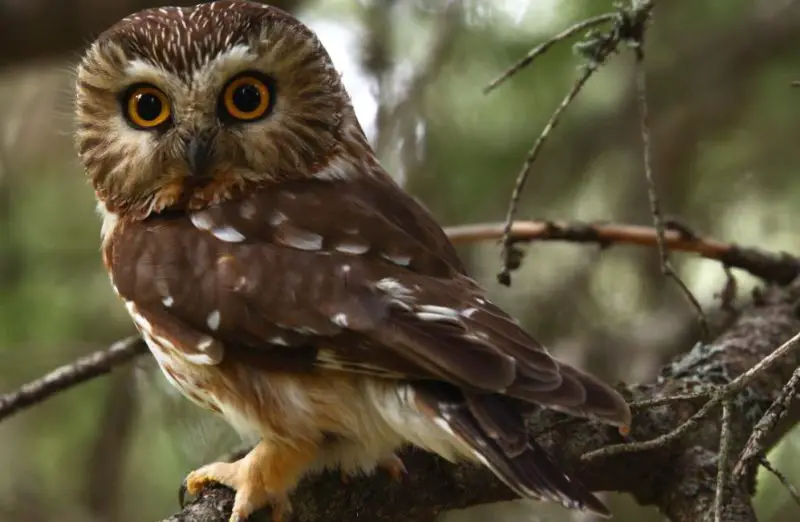
The Northern Saw-whet Owl is one of the smallest owls in Idaho, measuring only 7 to 8 inches in length with a wingspan under 18 inches. Its round head, large yellow eyes, and lack of ear tufts give it a charming, catlike appearance. The plumage is rich brown with white streaking on the forehead and chest, blending beautifully into dense conifer forests.
This owl gets its name from its call, which resembles the rhythmic sharpening of a saw on a whetstone. Though small, it is a fierce hunter that feeds primarily on small rodents such as deer mice and voles. It hunts silently at night, often perching low on branches before making swift, direct attacks on unsuspecting prey.
Northern Saw-whet Owls are reclusive and prefer thick forest cover for roosting during the day. They often occupy abandoned woodpecker holes or nest boxes for breeding. During migration periods, they may be spotted roosting close to the ground in dense shrubs, relying on camouflage for protection. Their nocturnal habits make sightings rare, but their distinctive calls can be heard echoing through Idaho’s mountain valleys.
In Idaho, they are commonly found in forested regions of the northern Panhandle, the Sawtooth Range, and higher elevations in central Idaho. During winter, some individuals move into lower altitudes where prey is more abundant. These small owls play an important role in controlling small mammal populations within the state’s forest ecosystems.
Long-eared Owl (Asio otus)
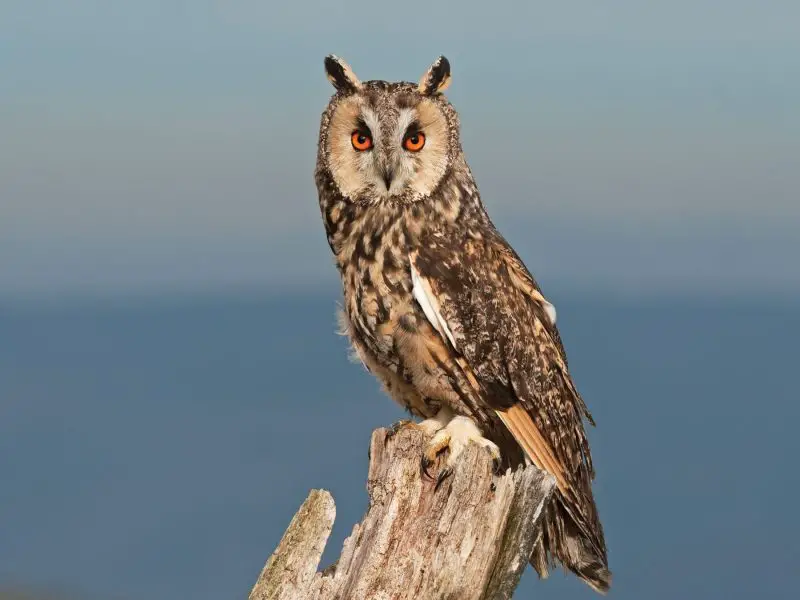
The Long-eared Owl is a slender, medium-sized owl with strikingly long ear tufts that give it a distinctive silhouette. Measuring 13 to 16 inches in length and with a wingspan of up to 40 inches, it appears tall and narrow when perched. Its orange facial disks, streaked chest, and mottled brown plumage provide excellent camouflage among branches and conifer boughs.
Unlike the Great Horned Owl, the Long-eared Owl is a more secretive and communal species. During the nonbreeding season, several individuals may roost together in dense tree stands, making them difficult to detect. Their calls consist of soft, low hoots given at regular intervals, often heard during spring courtship displays at dusk.
These owls are agile hunters, relying on stealth and speed to capture small mammals, especially voles and mice. They prefer open habitats for hunting, such as grasslands and meadows, but require dense nearby woodlands for roosting and nesting. Instead of building their own nests, they use abandoned stick nests from crows or magpies.
In Idaho, Long-eared Owls are distributed widely across southern and central regions, particularly in areas where grasslands meet forests or shrub-steppe. They are often found in riparian zones lined with willows or cottonwoods. Because of their nocturnal habits and cryptic plumage, they remain one of Idaho’s most elusive yet fascinating owl species.
Short-eared Owl (Asio flammeus)
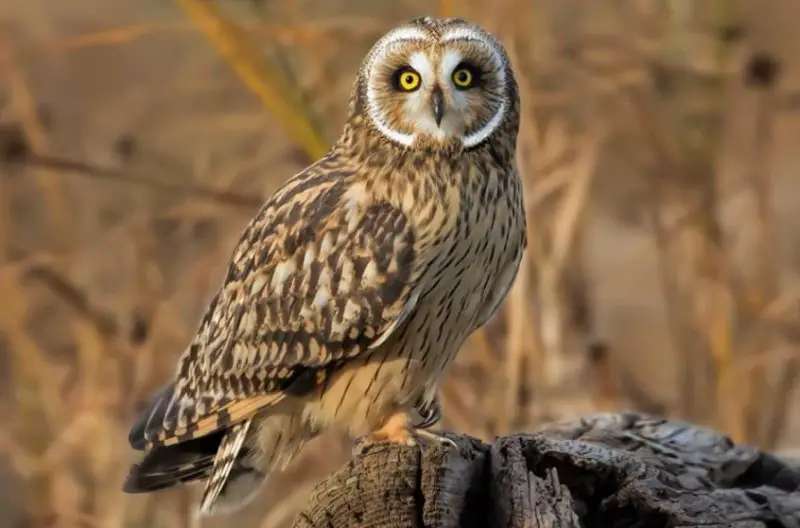
The Short-eared Owl is one of Idaho’s most frequently observed owls in open country, recognized for its graceful, buoyant flight and striking golden-yellow eyes. Measuring 13 to 17 inches in length with a wingspan reaching 3.5 to 4 feet, it appears larger in flight than when perched. Its plumage is buffy brown with streaking, offering excellent camouflage among grasses and reeds.
This owl’s ear tufts are very short and often invisible, which makes its round-headed profile distinctive among medium-sized owls. During flight, its wings show pale patches near the tips, and it often flies close to the ground with slow, moth-like wingbeats while scanning for prey. Its call is a soft, barking “keow” or a series of hoots used mostly during the breeding season.
The Short-eared Owl is primarily diurnal or crepuscular, meaning it hunts during daylight hours or at twilight—an uncommon trait among owls. Its diet consists mostly of voles, mice, and small mammals, though it occasionally captures small birds. They often nest directly on the ground, concealed by tall grass or low vegetation, and rely heavily on open fields for survival.
In Idaho, Short-eared Owls are commonly found in the Snake River Plain, Camas Prairie, and the marshlands of southeastern Idaho. They favor grasslands, pastures, and wetlands where rodent populations are high. Seasonal in presence, some migrate south in winter, while others remain year-round where conditions allow.
Burrowing Owl (Athene cunicularia)
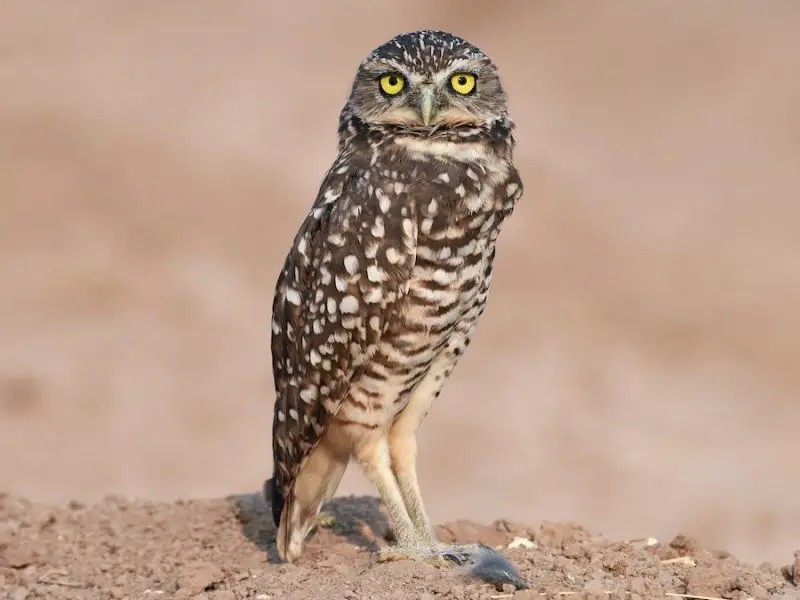
The Burrowing Owl is one of Idaho’s most distinctive and charismatic owl species. Unlike most of its relatives, it spends much of its time on the ground. Measuring about 9 to 11 inches in length with long, stilt-like legs and a short tail, it has bright yellow eyes and a white “eyebrow” that gives it a perpetual look of alertness. Its brown plumage is speckled with white spots, helping it blend into dry, open habitats.
This owl’s behavior is as unique as its appearance. It often stands upright on fence posts or the edges of burrow entrances during the day, scanning for insects and small mammals. Its calls are varied, including a short “coo-coo” and alarm chatter that resembles a small mammal’s bark. The Burrowing Owl’s long legs allow it to run swiftly across the ground, an adaptation rare among owls.
Burrowing Owls nest and roost in burrows abandoned by mammals such as ground squirrels or prairie dogs. They line these burrows with grass, manure, and feathers to regulate temperature and mask odor from predators. Diet-wise, they consume beetles, grasshoppers, small rodents, and even amphibians, adjusting their food intake depending on the season.
In Idaho, these owls are primarily found in the southern regions—especially in the Snake River Plain, Owyhee County, and the open grasslands near agricultural lands. Conservation efforts are underway in Idaho to protect this species, as habitat loss and ground squirrel control programs have reduced their available nesting sites.
Barred Owl (Strix varia)
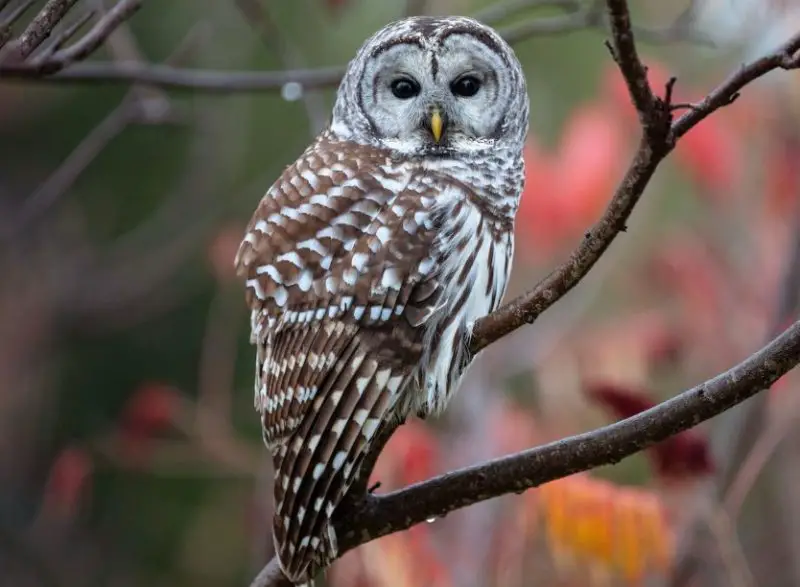
The Barred Owl is a large, heavy-bodied owl distinguished by its rich brown and white barred pattern across its chest and belly. Adults reach 17 to 20 inches in length, with wingspans up to 44 inches. Unlike many other owls, it lacks ear tufts, giving it a rounded, gentle facial disk framed by dark rings and deep brown eyes—an uncommon feature among owls in North America.
Its famous call, often described as “Who cooks for you? Who cooks for you all?” is one of the most recognizable sounds in wooded areas where it resides. Barred Owls are primarily nocturnal but may also hunt at dawn or dusk, preying on small mammals, amphibians, birds, and occasionally fish. They are opportunistic feeders and highly adaptable to a variety of wooded habitats.
Barred Owls prefer mature forests with dense canopy cover and access to nearby water sources such as rivers or swamps. They use large tree cavities for nesting and often return to the same breeding sites annually. Their flight is silent and deliberate, gliding effortlessly through dense timber in search of prey.
In Idaho, Barred Owls are recent arrivals, gradually expanding westward from the Great Lakes region into the forests of northern Idaho. They are now well established in the Panhandle, particularly in forested areas near Coeur d’Alene and Priest Lake. Their expansion has led to increased encounters with the native Spotted Owl, creating conservation concerns in overlapping habitats.
Great Gray Owl (Strix nebulosa)
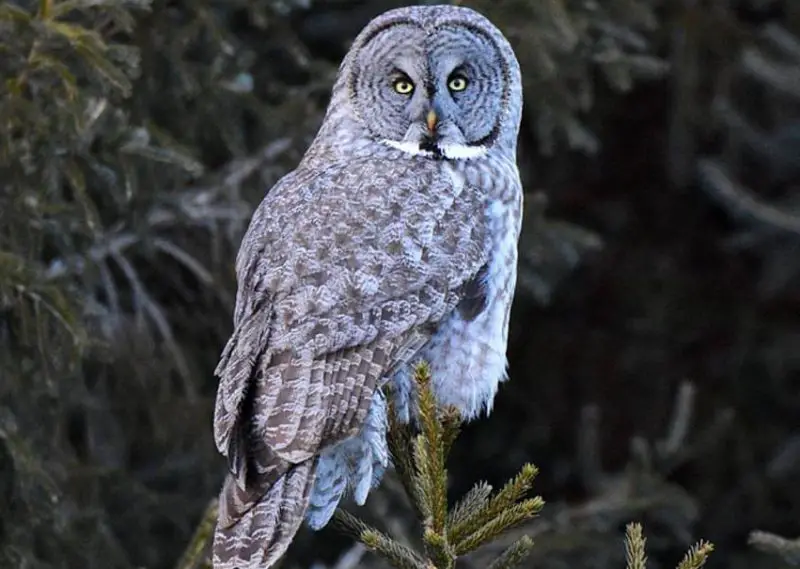
The Great Gray Owl is Idaho’s largest and most majestic owl, often referred to as the “Phantom of the North.” Despite its impressive size—up to 33 inches in length with a 5-foot wingspan—it is lighter than the Great Horned Owl due to its fluffy plumage. Its facial disk is massive and round, with concentric gray and white rings framing piercing yellow eyes.
This owl’s plumage is a stunning blend of silver-gray with fine streaks and barring, which provides exceptional camouflage against the bark of pine and fir trees. Its quiet demeanor and soft, rhythmic hoots add to its ghostly reputation. The Great Gray Owl hunts primarily at dusk and dawn, relying on acute hearing to detect small mammals moving under deep snow.
It is a patient hunter, often perching silently for long periods before plunging feet-first through snow to seize prey. Its diet consists mainly of voles, pocket gophers, and other small rodents. Unlike many owls, it doesn’t migrate long distances but may move to lower elevations during severe winters in search of food.
In Idaho, Great Gray Owls inhabit the northern and eastern mountain ranges, including the forests near Yellowstone, the Sawtooths, and the Selkirk Mountains. They favor subalpine meadows and dense conifer forests interspersed with clearings. Though elusive and rarely seen, their haunting beauty and serene presence make them one of Idaho’s most treasured wildlife species.
Northern Pygmy-Owl (Glaucidium gnoma)
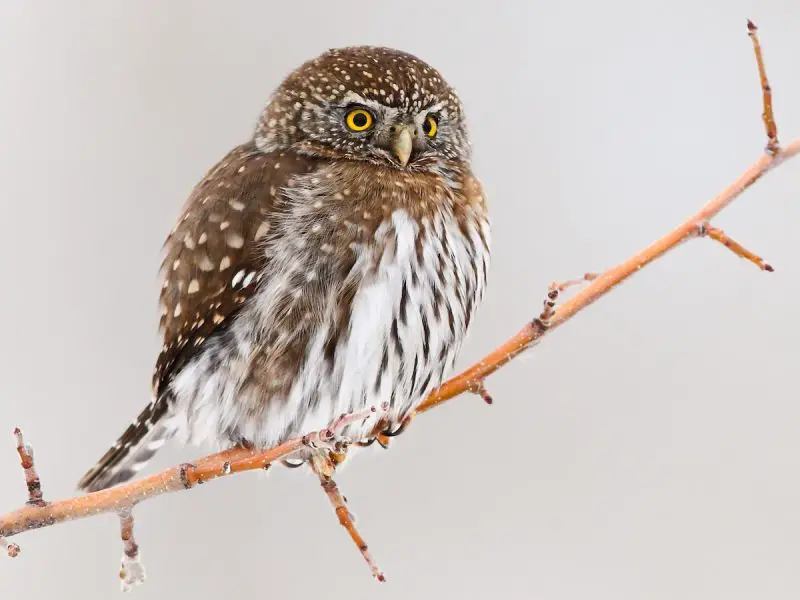
The Northern Pygmy-Owl is a small but fierce predator, measuring only about 6 to 7 inches long with a wingspan under 15 inches. Despite its size, it exudes confidence, often perching conspicuously on exposed branches during daylight hours. Its round head lacks ear tufts, and its brownish plumage with white spotting helps it blend with forest surroundings.
This owl’s face is framed by fine white streaks, and it has bright yellow eyes that convey a piercing intensity. Interestingly, the back of its head features two dark “false eyes” that may confuse predators or prey. Its call is a series of clear, whistled notes repeated at steady intervals, often heard in the quiet of early morning or late afternoon.
Unlike most owls, the Northern Pygmy-Owl is diurnal, hunting primarily in the daytime. It preys on small birds, mice, and insects, often capturing prey nearly its own size. It uses surprise and agility rather than stealth, darting swiftly between perches to strike unsuspecting victims. It frequently caches extra food in tree cavities for later consumption.
In Idaho, this species thrives in mixed coniferous forests, foothills, and wooded canyons across both northern and central regions. They are especially common in the Boise foothills, Sawtooth Mountains, and northern Panhandle forests. Though small and often overlooked, the Northern Pygmy-Owl plays an important ecological role in controlling small bird and rodent populations.
Flammulated Owl (Psiloscops flammeolus)
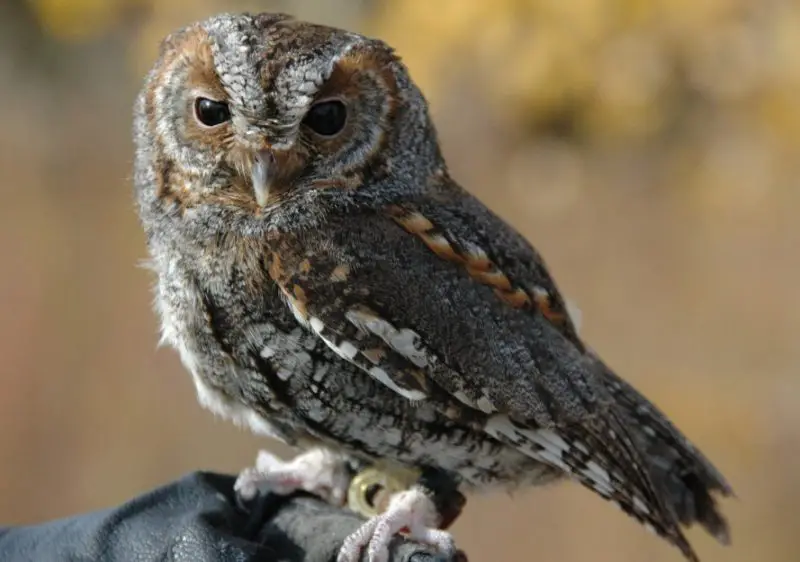
The Flammulated Owl is one of the smallest owl species in North America, measuring just 6 to 7 inches in length and weighing less than 2 ounces. Its name, “flammulated,” refers to the flame-like reddish or rusty streaks across its grayish-brown plumage. These markings, combined with its subtle coloring, make it nearly invisible against the bark of ponderosa pines where it roosts.
This diminutive owl is notable for its dark eyes—an uncommon trait among small owls, which usually have yellow eyes. Its facial disk is bordered by fine white and rufous feathers, giving it a soft, delicate appearance. Its call is a deep, soft “boo-boo-boo,” surprisingly low for its size, and is often mistaken for the sound of a distant frog on summer nights.
Flammulated Owls are strictly insectivorous, feeding primarily on moths, beetles, and crickets, which they catch in midair or pick off pine needles. They are nocturnal hunters that rely on keen hearing and silent flight to capture prey. Unlike many other owls, they migrate south in winter, traveling as far as Central America to escape Idaho’s cold season.
In Idaho, these owls inhabit dry, open ponderosa pine and Douglas-fir forests, especially in the southern and central mountain ranges. They arrive in late spring to breed and depart again by early autumn. Because of their cryptic coloration and quiet behavior, spotting one is a rare privilege, often reserved for those exploring Idaho’s forested highlands at dusk.
Snowy Owl (Bubo scandiacus)
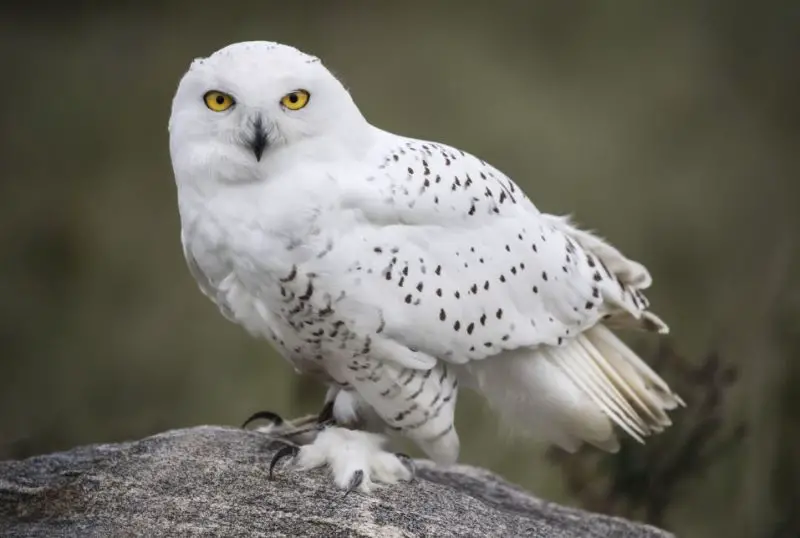
The Snowy Owl is one of the most striking and powerful owls to occasionally grace Idaho’s winter landscapes. Covered in thick white plumage with scattered dark barring, this large owl can measure up to 27 inches long with an impressive 5-foot wingspan. Its bright yellow eyes and black beak contrast beautifully with its snowy feathers, making it unmistakable in open terrain.
Adapted to the Arctic tundra, Snowy Owls are well-suited for cold climates and sometimes move south into Idaho during “irruption years,” when food becomes scarce in their northern range. Females and younger birds typically show more dark barring, while mature males are nearly pure white. Their call is a deep, booming hoot, though they are usually silent during their winter visits.
These powerful owls are diurnal, often seen hunting during the day. They rely heavily on vision to locate prey and will perch on fence posts, hay bales, or airport structures while scanning for small mammals like voles, lemmings, and rabbits. Their hunting style is methodical, consisting of long, low glides across open ground before striking.
In Idaho, Snowy Owls are rare but awe-inspiring visitors. They are most often sighted in the open farmlands of southeastern and southwestern Idaho, particularly around the Snake River Plain and near Pocatello or Idaho Falls. Airports and large agricultural fields mimic their native tundra environment, offering the open visibility they prefer for hunting.
Boreal Owl (Aegolius funereus)
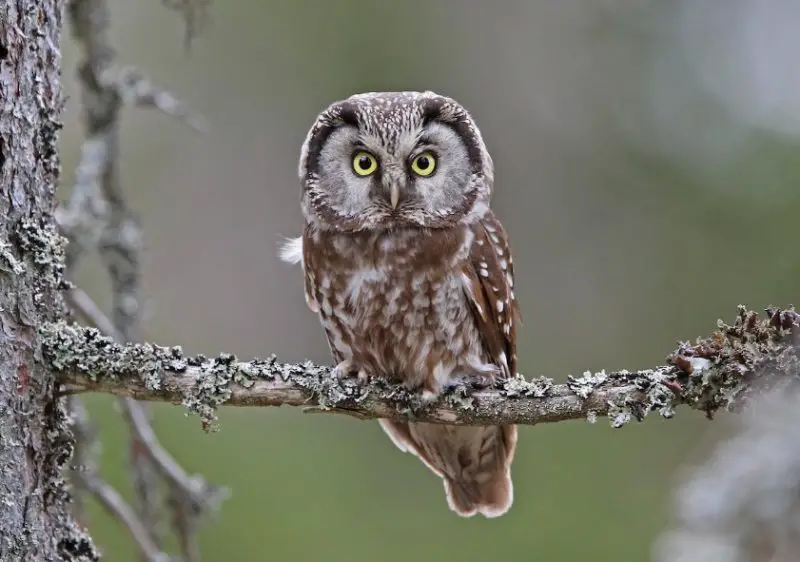
The Boreal Owl is a secretive, nocturnal species that thrives in Idaho’s cold, mountainous forests. Measuring 8 to 10 inches long with a wingspan of around 22 inches, it has a compact build and a rounded head with no ear tufts. Its plumage is chocolate-brown above and pale below, speckled with white spots on the head and back. The large, square facial disk highlights its bright yellow eyes, giving it an intense, inquisitive expression.
This owl’s call is a rhythmic series of soft, hollow hoots that echo through the night during the breeding season. It is a sound more often heard than the bird itself is seen, as Boreal Owls prefer dense conifer cover for roosting and nesting. They nest in old woodpecker holes, laying their eggs in deep forest cavities to protect against harsh mountain weather.
Their diet consists mostly of voles, mice, and small birds, which they capture by listening for movement under snow or leaf litter. Despite their size, Boreal Owls are efficient hunters capable of thriving in subalpine conditions. Their feathers are highly insulating, allowing them to remain active during freezing nights when most other birds are silent.
In Idaho, Boreal Owls are primarily found in the Panhandle and along the high-elevation spruce-fir forests of northern and central mountain ranges. They are particularly associated with the Selkirk and Bitterroot Mountains. Because of their secretive habits and remote habitat, sightings are rare, making them one of the state’s most mysterious owl species.
Spotted Owl (Strix occidentalis caurina)
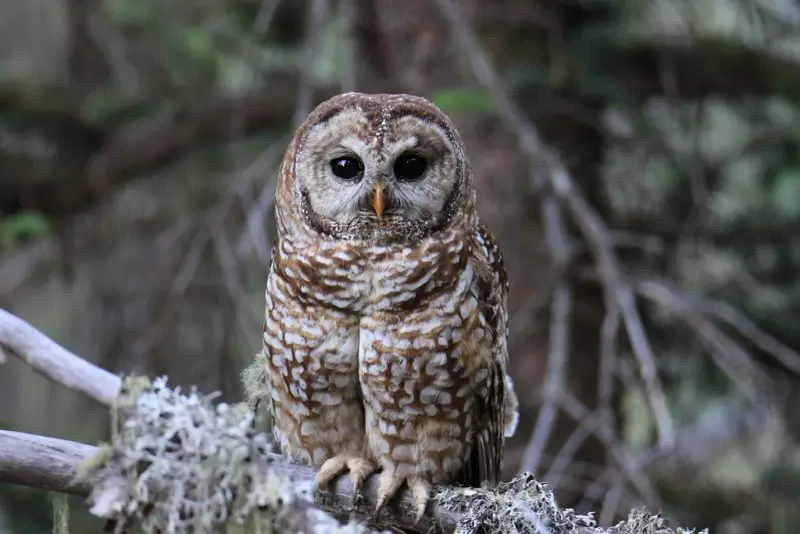
The Spotted Owl is one of Idaho’s rarest and most conservation-sensitive species. Measuring 16 to 19 inches in length, this medium-sized owl has rich brown plumage adorned with distinctive white spots and a rounded head without ear tufts. Its dark brown eyes—unusual among owls—lend it a soulful and gentle expression. Its overall appearance blends seamlessly into the shadowed understory of ancient forests.
This owl’s call is a series of deep, resonant hoots, often delivered in sets of four, which carry through the still forest air at night. Unlike many owls that occupy open landscapes, the Spotted Owl relies on old-growth forests with dense canopy layers and large trees for nesting, roosting, and hunting. It feeds primarily on small mammals such as flying squirrels and woodrats.
The Spotted Owl is a sedentary species, remaining in the same territory year-round. It is sensitive to habitat disturbance and depends on stable, mature forest ecosystems for survival. Competition from the expanding Barred Owl population in northern Idaho has further threatened its limited range.
In Idaho, the Northern Spotted Owl subspecies (Strix occidentalis caurina) is restricted to the extreme northern Panhandle, particularly in the old-growth forests near the Selkirk Mountains. Its presence indicates a healthy, undisturbed forest ecosystem. Unfortunately, due to logging and habitat fragmentation, it is now exceedingly rare, and conservation efforts are focused on protecting remaining suitable habitats.
Tips for Spotting Owls in Idaho
Know the Right Time of Day
Owls are primarily nocturnal, meaning your best chance to spot them is during the twilight hours—just before dawn or at dusk. However, some species like the Northern Pygmy-Owl and Short-eared Owl are active in daylight, making early morning or late afternoon excellent observation times. Bring binoculars and stay quiet; owls rely on their hearing, so even small noises can send them flying.
Look in the Right Habitats
Each owl species in Idaho favors a different environment. Barn Owls and Burrowing Owls prefer open farmland and grasslands, while Great Horned Owls and Barred Owls are often found in mixed forests and wooded river valleys. In contrast, Great Gray Owls and Boreal Owls inhabit the dense mountain forests of the north. Focus on edges between habitats—where forests meet fields—for the best chance of sightings.
Listen for Their Calls
Learning owl calls can dramatically improve your success in finding them. The deep hoots of the Great Horned Owl, the eerie screech of the Barn Owl, and the soft trills of the Western Screech-Owl are all unique identifiers. Even if you can’t see the owl, recognizing its call can help pinpoint its general location in the dark forest or open grassland.
Bring the Right Equipment
A good pair of binoculars, a flashlight with a red filter, and a field guide to Idaho’s birds are essential tools for owl watching. Red light is less disturbing to owls and helps you preserve your night vision. Dress warmly and use quiet, soft-soled shoes to move silently through the woods or fields. Patience is key—staying still and letting the forest quiet down often brings results.
Respect Wildlife and Their Habitats
Owls are sensitive to human disturbance, especially during nesting season. Avoid approaching nests or using bright lights that may disrupt their nocturnal behavior. Never use playback calls excessively, as this can cause stress and territorial confusion. Enjoy observing from a distance and appreciate Idaho’s diverse owl species without interference.
FAQs about Owls in Idaho
What is the most common owl species in Idaho?
The Great Horned Owl is the most common and widespread owl in Idaho. It thrives in nearly every habitat, from dense forests to desert canyons and farmlands. Its adaptability, strong hunting skills, and tolerance for human-altered landscapes make it a year-round resident across the entire state.
Are there snowy owls in Idaho?
Yes, but Snowy Owls are rare winter visitors. They occasionally appear in open areas like farmlands or airport fields during “irruption” years, when populations move south from the Arctic due to food shortages. These events are unpredictable, but sightings are more likely in southeastern and southern Idaho during harsh northern winters.
Where is the best place to see owls in Idaho?
Northern Idaho’s forests around Coeur d’Alene, Priest Lake, and Selkirk Mountains are excellent for forest-dwelling owls like the Barred, Great Gray, and Boreal Owls. Meanwhile, southern Idaho’s Snake River Plain and Owyhee County grasslands are prime habitats for Burrowing and Short-eared Owls. Riparian areas with old trees also provide great viewing opportunities.
When is the best season to look for owls in Idaho?
Spring and early summer are ideal because most owl species are nesting, and their vocal activity increases during courtship. However, winter brings special opportunities to spot migratory species like the Snowy Owl. Year-round residents such as the Great Horned Owl can be seen in any season, especially around dusk.
How can I attract owls to my property in Idaho?
To attract owls, maintain tall trees or install nest boxes appropriate for local species like Barn Owls or Western Screech-Owls. Avoid using rodenticides, as they can poison owls that feed on affected prey. Creating a habitat with open hunting areas and nearby trees will make your property more inviting to these nocturnal raptors.

